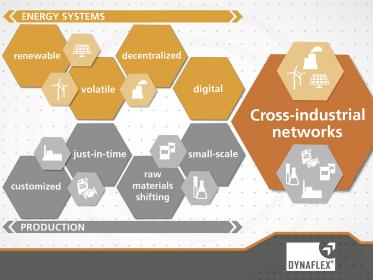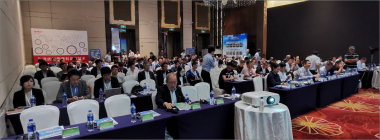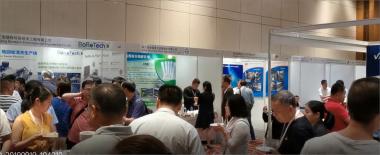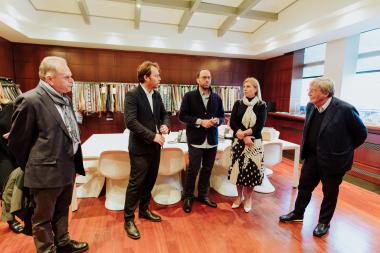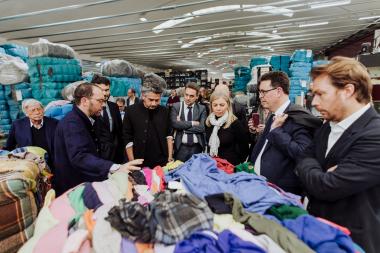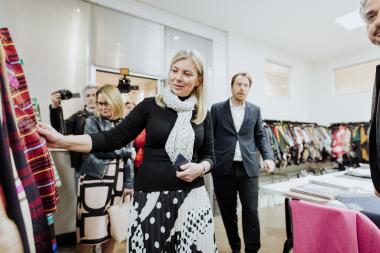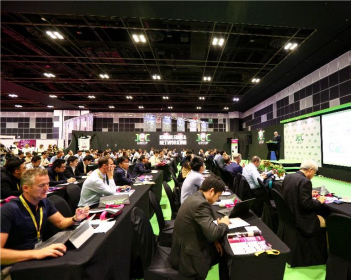DYNAFLEX® auf der e-World 2020
Die Energiewende ist eine tragende Säule des Strukturwandels und erfordert ein Umdenken in vielen Bereichen. Damit in einem zunehmend dynamischen und volatilen Umfeld erfolgreiche Wirtschafts-Ökosysteme wachsen können, sind aufeinander abgestimmte, anpassungsfähige Lösungen an der Schnittstelle von Energie- und Stoffwirtschaft notwendig. Genau hier setzt das Leistungszentrum DYNAFLEX® an und entwickelt unter Federführung des Fraunhofer UMSICHT zukunftsfähige Lösungen. In Bad Langensalza entsteht zurzeit ein Pilotstandort, der als Vorreiter für cross-industrielle Netzwerke dienen soll und neue Wertschöpfungsketten erschließt.
Im Mittelpunkt aktueller Geschäftstätigkeiten und Unternehmensstrategien stehen zunehmend Technologien zur Effizienzsteigerung und zur Vermeidung von CO2-Emissionen. Eine nachhaltige und umweltschonende Wertschöpfung bedeutet zwar zunächst eine Umstellung für die Beteiligten, dient aber auch als klarer Wettbewerbsvorteil.
Um den deutschen Mittelstand im Wettbewerb gut zu positionieren und die Herausforderungen für einzelne Unternehmen zu senken, sehen Experten die Zukunft in einem gemeinsamen Vorgehen der Akteure in regionalen cross-industriellen Netzwerken. »Wertschöpfungsketten müssen künftig über die bisherigen Sektor- und Branchengrenzen hinausgehen. Warum nicht gemeinsam lokale Stoff-und Energieströme bestmöglich vor Ort verwerten? So können entscheidende Vorteile durch regionale Synergien entstehen«, erklärt Dr. Georg Janicki vom Fraunhofer UMSICHT in seiner Funktion als Manager des Leistungszentrums DYNAFLEX®. Das Leistungszentrum plant in enger Zusammenarbeit von Wissenschaft und Unternehmen zukunftsfähige Schnittstellenprojekte für die Energie- und Grundstoffwirtschaft.
Dynamische Betriebsführung
Um die lokalen Energie- und Stoffströme nachhaltig zu gestalten, muss bereits die Energieversorgung entsprechend ausgelegt sein. Die Einbindung von Strom aus erneuerbaren Energien in z. B. Produktionsanlagen unterliegt jedoch zeitlichen und standortspezifischen Schwankungen – bedingt durch Tages-/Nachtzeit und Windaufkommen. Hinzu kommen Aspekte wie eine kundenspezifische Fertigung und damit variierende Anforderungen an Produkte, die zudem just-in-time gefertigt und geliefert werden müssen. Und auch variierende Rohstoffe aufgrund von sich verändernden Rahmenbedingungen (markt- und kundenseitig) und die Umstellung auf umweltfreundlichere Rohstoffe müssen berücksichtigt werden.
In einem Gewerbegebiet im thüringischen Bad Langensalza wird ein Pilotprojekt umgesetzt, in dem ein Netzwerk mit unterschiedlichen Akteuren auf Basis von regenerativen Energien und nachhaltigen Rohstoffen implementiert wird. Das Projekt nimmt eine nationale und internationale Vorreiterrolle bei der Umsetzung klimaschonender und sektorübergreifender Technologien ein. Verschiedene Partner aus der Wirtschaft wollen mit Unterstützung des Fraunhofer UMSICHT in einem gemeinsamen Vorhaben eine Freiflächen-Photovoltaikanlage errichten. Der produzierte Strom soll durch innovative und nachhaltige Konzepte direkt in bereits bestehende und neue Wertschöpfungsketten der benachbarten Wirtschaftsunternehmen eingebunden werden. Die Konzepte tragen zur Netzstabilität bei und ermöglichen den Aufbau eines neuen Technologieclusters auf Basis nachhaltiger Rohstoffe und Energieträger. Dadurch wiederum sollen sich neue Unternehmen in der Region ansiedeln.
Unabhängig von fossilen Rohstoffen
Forschende des Fraunhofer UMSICHT arbeiten des Weiteren an einem Power-to-Gas-Konzept. Mit PV-Strom betriebene Elektrolyseanlagen sollen Wasserstoff erzeugen, der direkt ins Erdgasnetz eingespeist und für Produktionsprozesse verwendet werden kann. Auch kann der Wasserstoff mit CO2 zu Methan veredelt bzw. zu Basisprodukten der chemischen Industrie, Kunststoffindustrie, Düngemittelindustrie oder Treibstoffindustrie weiterverarbeitet werden.
E-world: Cross-industrielle Netzwerke spielerisch verstehen
Das Leistungszentrum DYNAFLEX® präsentiert sich auf der E-world energy & water, vom 11. bis 13. Februar 2020 in Essen. Am Messestand können anhand eines Exponats verschiedene aktuelle Aspekte und Herausforderungen in der Energie- und Grundstoffwirtschaft spielerisch erfahren werden. Angelehnt an den bekannten »heißen Draht« werden modellhaft durch unterschiedliche Verläufe zweier Drähte die Komplexität der jeweiligen Akteure und deren Herausforderungen bei einer Sektorenkopplung nachgestellt. Auf diese Weise wird die Notwendigkeit cross-industrieller Netzwerke, wie sie z. B. in Bad Langensalza geplant sind, veranschaulicht.


